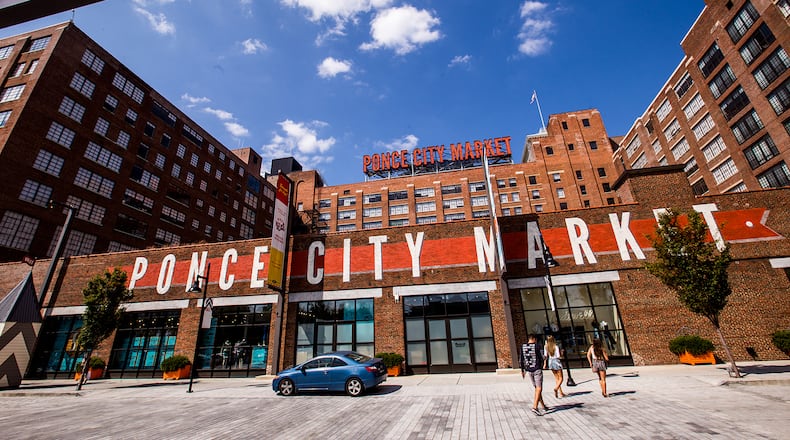Sears may be liquidating its stores left and right, but the company's historic distribution centers are experiencing major comebacks.
Ponce City Market's up-from-the-ashes story is a well-known tale of adaptive reuse but it's not unique. For two decades, developers have been turning those hulking Sears warehouses into live-work-play centers.
Here's why. Sears built huge distribution plants across the country in the first decades of the 20th century. Like Atlanta's complex, these sprawling warehouses were built on rail lines on what was then the outskirts of town. As noted by Benjamin Schneider in CityLab, these sister giants have similar storylines -- a heyday in the 1950s followed by steady decline and abandonment, then rediscovery by developers in recent years.
The old Sears plants are attractive for reuse for a number of reasons -- large square footage, stong floors and iconic architectural elements such as Ponce City Market's tower. As for the adjacent rail lines, some of them are being turned into trails and parks just as the Atlanta Beltline has been.
Everyone loves a comeback. Here are some of the second lives of Sears warehouses.
Credit: McGhiever
Credit: McGhiever
Minneapolis (1928): Known as Midtown Exchange since 2006, with office, residential and commercial use. Sears used the building until 1994 and it lay vacant for 11 years. It also hosts Midtown Global Market, a food and vendor hall specializing in ethnic restaurants and community arts programs. The Midtown Greenway is a 5.7-mile trail converted from railroad tracks.
Credit: Bruner/Cott
Credit: Bruner/Cott
Boston (1929): Sears closed this building in 1988. It reopened in 2000 as Landmark Center with retail and office space, including several tenants in the medical field. The complex includes a movie theater, health club and day care center. The building is adjacent to Boston's "Emerald Necklace" network of parks.
Credit: Jamestown Properties
Credit: Jamestown Properties
Atlanta (1925): One of the south's largest buildings, Sears shuttered its Ponce de Leon plant in 1987. Four years later, Mayor Maynard Jackson purchased the complex and remade it City Hall East. It too fell vacant by the time it was sold to developers in 2011. It reopened in 2014 as Ponce City Market and quickly became the most popular destination on the Beltline's Eastside Trail. It includes office and retail space, apartments, an upscale food court and a rooftop amusement park.
Credit: Library of Congress
Credit: Library of Congress
Chicago (1906): Built in the city where Sears, Roebuck and Company was born, this 41-acre complex was the world's largest commercial building. It served as Sears' main distribution center and opened the first Sears retail store in 1925. Its corporate headquarters stayed here until moving to the Sears Tower in 1973. The rest of the plant became vacant in 1987.
Credit: John Delano
Credit: John Delano
In 1992, the site was mostly demolished and what was left was redeveloped as Homan Square. Among the remaining four buildings is the iconic tower, now known as Nichols Tower, which is home to the School of the Art Institute of Chicago.
Dallas (1910): This Sears distribution center closed its doors in 1993. Developers bought the building four years later and reopened it in 2000 as South Side on Lamar, with residential, office and retail space, including restaurants and a grocery store.
Credit: Park Lofts
Credit: Park Lofts
North Kansas City (1913): Sears didn't occupy this plant for long. Most of the building was used during World War I as soldiers barracks and military equipment storage. Sears moved out of the building in 1925 when the company built a new plant across town. Other smaller businesses continued to occupy the building over the years until 1999, when it was renovated and reopened as Northland Lofts. Today it is known as Park Lofts.
Credit: Wesley H. Brewton
Credit: Wesley H. Brewton
Seattle (1912): This building was constructed by Union Pacific Railroad as a way to lure Sears to Seattle. Sears remained in the building until 2014 alongside other office tenants. One of those tenants, Starbucks, moved its headquarters to the building in 1997 and the building has been known as Starbucks Center ever since. The building is also notable for being the oldest and largest in the U.S. to earn a national green certification.
Credit: Downtowngal
Credit: Downtowngal
Los Angeles (1927): Sears shut down its mail-order operations here in 1992 but a retail store remains in operation on the ground floor. Developers bought the building in 2013 and are renovating it to include apartments, retail and office space. Plans for the Mail Order District, as it will be called, include a food court and repurposed rail cars.
Credit: Thomas R Machnitzki
Credit: Thomas R Machnitzki
Memphis (1927): This facility, designed by the same architect behind the Ponce City Market building, was abandoned by Sears in 1993. The building sat empty for 17 years before renovations began. It reopened in 2017 as Crosstown Concourse. Like Ponce City Market, the space includes apartments, offices, restaurants and stores.
Philadelphia (1920): Some Sears plants didn't make the transition to live-work-play facilities. Philadelphia's plant was sold by Sears in 1993 and was demolished the next year. Only a few building elements remain, including a power plant that's now known for a Home Depot advertisement on its smokestack. The plant's fire station is still in business too, in a building specially constructed as a miniature of the original plant headquarters.
Credit: Library of Congress
Credit: Library of Congress
Kansas City (1925): This facility was demolished in 1997. The site is now used as a large distribution center for the U.S. Postal Service.
About the Author
Keep Reading
The Latest
Featured













